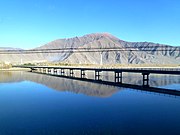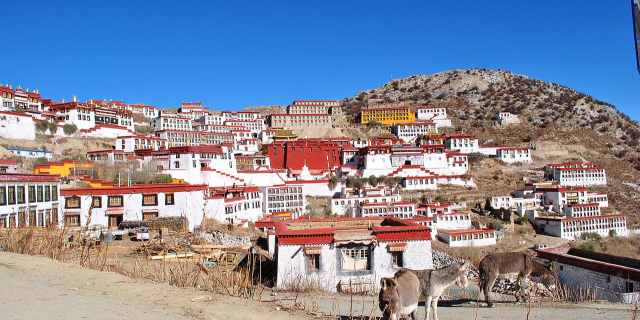曲水铁索桥
( Chushul Chakzam )The Chushul Chakzam (Tibetan: ཆུ་ཤུལ་ལྕགས་ཟམ), or simply Chakzam which literally means "iron bridge" in Standard Tibetan, was a suspension bridge that spanned the Yarlung Tsangpo river in modern-day Qüxü County near Lhasa, Tibet. It was built in 1430 by Thang Tong Gyalpo. The southern bridgehead was built on the mountain Chowuri, which is sacred in Tibetan Buddhism. This mountain was a site where Guru Rinpoche and Trisong Detsen had meditated during the 8th Century. When it was built, its main section was the longest unsupported span in the world, with a central span estimated at around 150 yards (140 metres).
In 1444, a monastery Chaksam Chuwori (Tibetan: ལྕགས་ཟམ་ཆུ་བོ་རི) was founded on the southern bridgehead. During its existence, the monastery...Read more
The Chushul Chakzam (Tibetan: ཆུ་ཤུལ་ལྕགས་ཟམ), or simply Chakzam which literally means "iron bridge" in Standard Tibetan, was a suspension bridge that spanned the Yarlung Tsangpo river in modern-day Qüxü County near Lhasa, Tibet. It was built in 1430 by Thang Tong Gyalpo. The southern bridgehead was built on the mountain Chowuri, which is sacred in Tibetan Buddhism. This mountain was a site where Guru Rinpoche and Trisong Detsen had meditated during the 8th Century. When it was built, its main section was the longest unsupported span in the world, with a central span estimated at around 150 yards (140 metres).
In 1444, a monastery Chaksam Chuwori (Tibetan: ལྕགས་ཟམ་ཆུ་བོ་རི) was founded on the southern bridgehead. During its existence, the monastery served as the seat of Chakzampa school of Tibetan Buddhism. Supported by the bridge toll, the monastery at one point hosted about 100 monks. The monastery was destroyed during the Cultural Revolution.
By the 1860s, the bridge was in a state of disrepair that a ferry was in operation slightly upstream offering safer passage.[1] By 1904, the river had overflown the north bank leaving the northern bridgehead on an island, thus rendering the bridge functionally ineffective.[2] The ferryman mostly came from a nearby village of Chun or Junba, which is the only fishing village in Tibet.[3][4][5] The ferry service continued as late as 1959.[3]
During the Qing expedition to Tibet of 1910, the 13th Dalai Lama decided to seek refuge in India. His general Tsarong fought a skirmish against the Chinese here, holding their advances allowing the Dalai Lama to safely arrive in India.[6]
The bridge was torn down by the Chinese government in the 1950s when they were building the concrete bridge in its place.[7] The new concrete bridge Qushui Yaluzangbujiang Bridge opened on August 1, 1966.[8]






































Add new comment